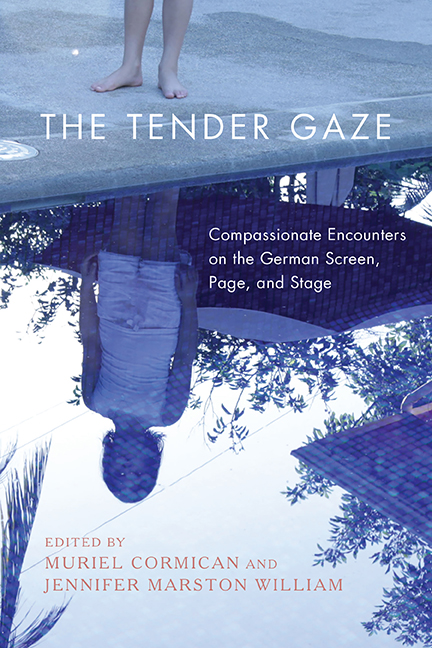Book contents
- Frontmatter
- Contents
- Acknowledgments
- Introduction: The Tender Gaze
- 1 Toward a Theory of the Tender Gaze: Affect, Critical Insight, and Empathy in Contemporary German Cinema
- 2 The Tender Gaze, Embodied Politics, and Perspective-Taking in German Postdramatic Theater
- 3 Face to Face: Race, Gender, and the Gaze in Mo Asumang’s Die Arier
- 4 “Risse, hinter denen man einen Kern entdeckt, der so ähnlich ist wie die Herzen von uns allen”: The Tender Gaze in Umut Dağ’s Risse im Beton
- 5 Looking through the Eyes of Empathy: Encouraging a Culture of Caring and Compassion in Doris Dörrie’s Keiner liebt mich
- 6 The Tender and Transgressive Beast Within: Escape Narratives in Films by Krebitz, Stuber, and Speckenbach
- 7 Looking at Looking in Margarethe von Trotta’s Das Versprechen
- 8 A Queer Phenomenology of Gender in Maren Ade’s Alle Anderen and Toni Erdmann
- 9 Rilke’s “Schauen”
- 10 Pity Stares or Tender Gaze? Seeing Disability in Nineteenth-Century Austrian and German Literature
- 11 The Sociohistorical and Gendered Implications of Gazing Tenderly in Ludwig Tieck’s “Liebeszauber”
- 12 Mothering, Animals, and the Surveillance State in the Anthropocene: An Ecofeminist Reading of Birgit Vanderbeke’s Die Frau mit dem Hund
- Notes on the Contributors
- Index
3 - Face to Face: Race, Gender, and the Gaze in Mo Asumang’s Die Arier
Published online by Cambridge University Press: 05 October 2022
- Frontmatter
- Contents
- Acknowledgments
- Introduction: The Tender Gaze
- 1 Toward a Theory of the Tender Gaze: Affect, Critical Insight, and Empathy in Contemporary German Cinema
- 2 The Tender Gaze, Embodied Politics, and Perspective-Taking in German Postdramatic Theater
- 3 Face to Face: Race, Gender, and the Gaze in Mo Asumang’s Die Arier
- 4 “Risse, hinter denen man einen Kern entdeckt, der so ähnlich ist wie die Herzen von uns allen”: The Tender Gaze in Umut Dağ’s Risse im Beton
- 5 Looking through the Eyes of Empathy: Encouraging a Culture of Caring and Compassion in Doris Dörrie’s Keiner liebt mich
- 6 The Tender and Transgressive Beast Within: Escape Narratives in Films by Krebitz, Stuber, and Speckenbach
- 7 Looking at Looking in Margarethe von Trotta’s Das Versprechen
- 8 A Queer Phenomenology of Gender in Maren Ade’s Alle Anderen and Toni Erdmann
- 9 Rilke’s “Schauen”
- 10 Pity Stares or Tender Gaze? Seeing Disability in Nineteenth-Century Austrian and German Literature
- 11 The Sociohistorical and Gendered Implications of Gazing Tenderly in Ludwig Tieck’s “Liebeszauber”
- 12 Mothering, Animals, and the Surveillance State in the Anthropocene: An Ecofeminist Reading of Birgit Vanderbeke’s Die Frau mit dem Hund
- Notes on the Contributors
- Index
Summary
GERMAN DOCUMENTARY FILMMAKER MO Asumang jokes that she has always been drawn to controversial subjects. A consummate interviewer, Asumang honed her skills from 1997 to 2000 as the moderator of the Pro7 cable television sex-talk show “Liebe Sunde” (Dear Sin/Love Sin—there is a double meaning here in German). However, even she did not expect to become the target of a death threat by a right-wing “Hate Rock” band. Although she had previously experienced both verbal and physical abuse from racists, as she told an interviewer for the Berlin newspaper Der Tagesspiegel in 2016, having the neo-Nazi band White Aryan Rebels call for her execution in the song “Diese Kugel ist fur dich!” (This bullet is for you!) was a new experience for her. In her 2016 autobiography Mo und die Arier: Allein unter Rassisten und Neonazis (Mo and the Aryans: Alone Among Racists and Neo-Nazis), Asumang details the paralyzing effect of hearing the lyric “Diese Kugel ist fur dich, Mo Asumang!” Recognizing that racists rarely know anyone from the groups they hate, she decided that she needed to meet some neo-Nazis in order to try to understand what lay hidden behind their mask of hatred. But instead of openly judging or condemning neo-Nazis, skinheads, and members of the Ku Klux Klan, among other racists, Asumang employs open communication, dialogue, and the tender gaze as her primary strategies of engagement.
In theorizing the tender gaze, Muriel Cormican explicitly frames this positionality as one that sidesteps objectification and visual pleasure in fiction film. My use of the term here, however, inserts it into a somewhat different arena, as I apply the concept of an empathetic, gentle gaze within the framework of the nonfiction film. I argue that, in her film Die Arier (The Aryans, 2014), Asumang employs the tender gaze on two levels: first, in her on-screen persona with her interlocutors, and second, as the filmmaker through whose eyes the spectator views the onscreen interaction. Asumang's iteration of the tender gaze emerges in the ways in which she interacts with her subjects from her positions both in front of and behind the camera.
- Type
- Chapter
- Information
- The Tender GazeCompassionate Encounters on the German Screen, Page, and Stage, pp. 60 - 75Publisher: Boydell & BrewerPrint publication year: 2021



